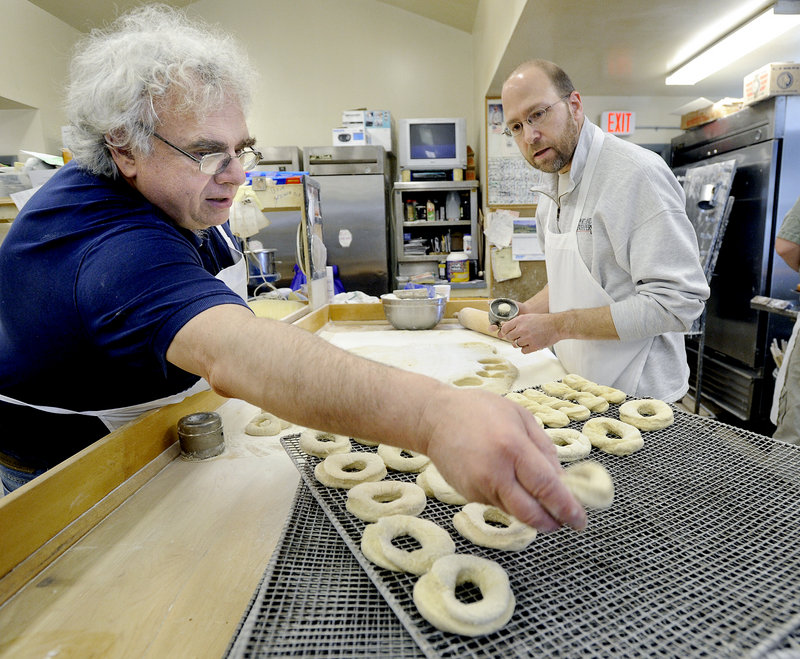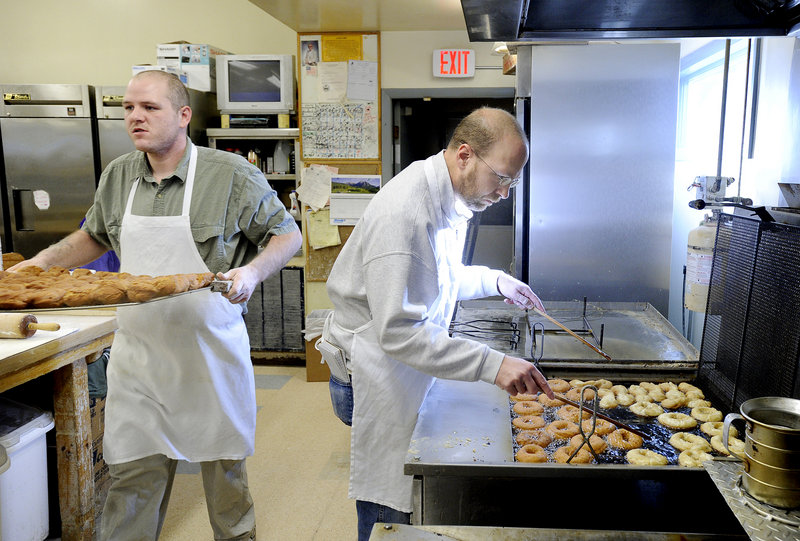PORTLAND – Trapper Proulx gave me two long wooden sticks and told me I could flip the doughnuts.
In front of me was a giant deep fryer, a vat of bubbling oil with a surface about as big as your average stovetop. A dozen or more plain doughnuts were floating in the oil.
My first question was: When do I flip them? I was hoping for a specific answer, such as “in three minutes.” But I soon learned that Proulx, a 10-year veteran doughnut maker at Tony’s Donuts in Portland, didn’t have a lot of specific answers.
“When they’re done on one side,” was Proulx’s reply to my flipping question.
A few seconds later, he mentioned that I could watch for “the blossom” of the doughnut. In doughnut-making parlance, “the blossom” is the slight cracking and spreading of the crust inside the hole. When you see that happening, there’s a good chance it’s time to flip the doughnut and let the other side cook.
When I saw some doughnuts begin to “blossom,” I picked up the two wooden sticks and tried to use them, chopstick-style, to grab a doughnut and flip it over. Leaning over the hot oil (“You should be here in the summertime,” Proulx told me), I couldn’t quite get a grip on the doughnut and ended up smearing some raw dough onto the cooked side before turning it over.
Then Proulx showed me his technique, which is just to poke the doughnut in one strategic spot to get it to flip. I tried it, but I ended up using the second stick anyway for more help.
And I ended up smearing more dough on the finished doughnuts.
“Don’t worry about that. We can clean those up after they cool down,” said Proulx, 30, of Buxton.
Throughout my morning at Tony’s, a Portland institution since the mid-1960s, I learned that making doughnuts by hand is filled with nuance and getting a feel for things.
Rick Fournier, son of founder Tony Fournier, was with Proulx and me during the doughnut-making session. He and Proulx tried to show me how to cut doughnuts quickly.
Fournier did it by taking a round doughnut cutter, plunging it into the dough, giving it a twist, then flipping the round piece of dough into one hand, while pushing the hole piece out and getting the rest of the round piece of dough to ring his thumb.
I watched him do it several times and couldn’t figure out how he pushed out the hole piece while getting the rest of the dough to land on his thumb so quickly.
His response to me, in part, was: “As you wander on through life, whatever be your goal, keep your eye upon the doughnut, and not upon the hole.”
That saying is engraved on his late father’s headstone, Fournier told me.
I never did figure out Fournier’s dough-cutting technique.
My version was to pop the hole piece out of the dough with my fingers, then grab the rest of the dough and put it on the frying screen.
That made my pieces of dough a little less circular, because of all the handling. But Fournier and Proulx did some stretching and patting to get them in doughnut shape before frying.
Before cutting the dough, Fournier had me roll it out with a giant rolling pin until it was about as thick as my finger. At that stage, he said, it is very important to lift the sheet of dough at certain points and let it flop back down on the table.
That will “let the air out,” Fournier told me, and prevent the doughnuts from shrinking later.
Tony’s advertises “hand-cut” doughnuts. The shop makes something like 250 dozen each day (about 3,000), so hand-cutting is pretty labor-intensive, because it’s done one doughnut at a time.
Many places the size of Tony’s use machines to cut doughnuts, Fournier says, but he doesn’t want to go the machine route.
“For me, it’s about the flavor,” said Fournier. “With hand-cut, the dough is denser. Machine-cut ones tend to absorb the grease more.”
Speaking of flavor, when I was making crullers I got the rare treat of eating a warm one, with still-warm glaze dripping all over it.
Crullers, at Tony’s anyway, are made with pieces of doughnut dough that are twisted twice and patted down in the middle to give them that distinctive shape. After some crullers had come out of the fryer, Proulx let me dip them in a giant vat of glaze — a very warm, gooey combination of powdered sugar, water and honey.
Proulx told me to be careful, because the crullers and the glaze were sort of hot.
He advised me to turn the crullers just enough to get them covered, but not to leave them in the glaze too long.
As I was dipping one, I broke it, at which point Proulx and Fournier told me, “You break it, you eat it.”
I didn’t have to hear that twice.
I popped the gooey cruller in my mouth and was in doughnut heaven. Until I realized my lips, beard, pants and shoes had drips of glaze all over them.
So I washed up and went back to work.
“After a while, you just get a feel for the job,” said Proulx.
I’m not sure I ever would.
But I could sure get a taste for it.
Staff Writer Ray Routhier can be contacted at 791-6454 or at:
rrouthier@pressherald.com
Send questions/comments to the editors.





Success. Please wait for the page to reload. If the page does not reload within 5 seconds, please refresh the page.
Enter your email and password to access comments.
Hi, to comment on stories you must . This profile is in addition to your subscription and website login.
Already have a commenting profile? .
Invalid username/password.
Please check your email to confirm and complete your registration.
Only subscribers are eligible to post comments. Please subscribe or login first for digital access. Here’s why.
Use the form below to reset your password. When you've submitted your account email, we will send an email with a reset code.